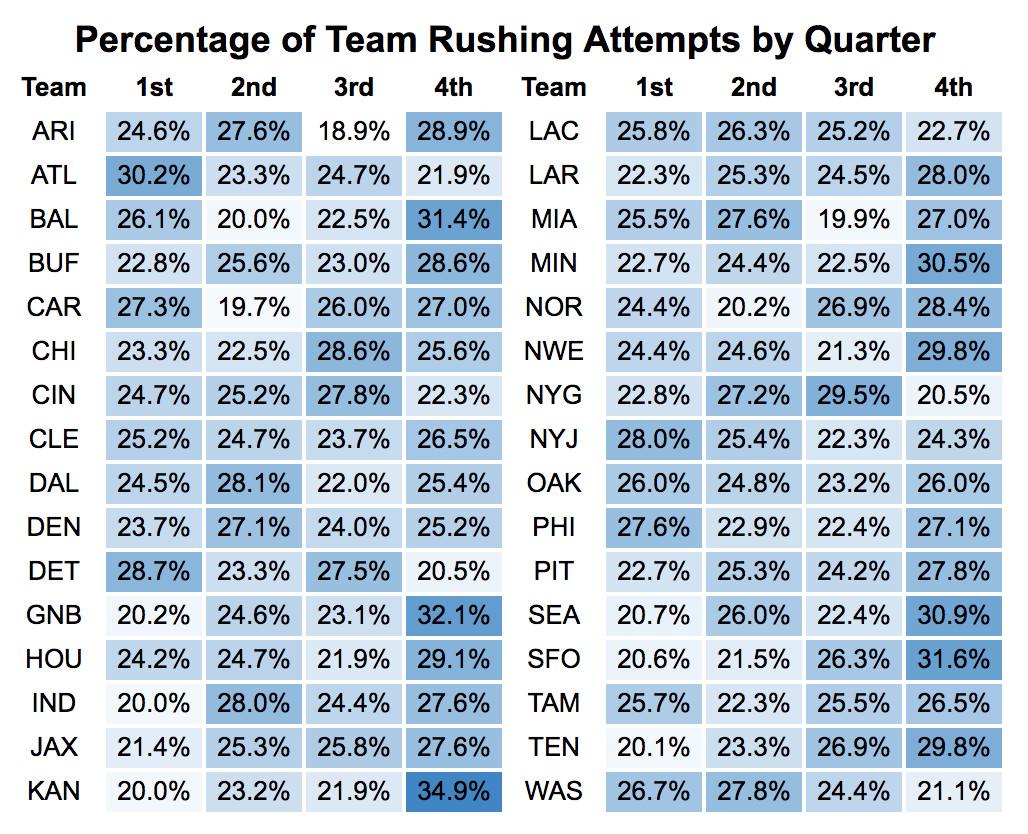Between the Ravens’ record-breaking offense, Christian McCaffrey’s all-time fantasy season, Derrick Henry’s second-half tear, and the 49ers’ playoff dominance, rushing has had a bit of a glow up this NFL season. Some of the league’s best players and offenses have done most of their work on the ground, seemingly bucking a decadeslong trend toward the air and rewriting ideas about the value of having an elite rushing offense. But no one told the Chiefs about all this.
Kansas City is headed to the Super Bowl thanks mostly to its supercharged offense. That group vaulted the team to the no. 2 seed in the AFC, finished third in offensive DVOA, and powered a 24-point comeback against the Texans and a 10-point one against the Titans in the playoffs. And Patrick Mahomes and Andy Reid did it despite fielding a round-robin of replacement-level running backs: former journeyman Damien Williams (498 yards), a past-his-prime LeSean McCoy (465), little-used sophomore Darrel Williams (141 yards), and sixth-round rookie Darwin Thompson (128 yards).
Conventional wisdom holds that NFL offenses should attempt to strike a balance between their passing and running games, but the Chiefs don’t even come close. An examination of their stats reveals that not only did Kansas City not get much out of its running backs, it frequently abandoned the running game altogether. Kansas City quietly pushed the limits of how heavily a team can rely on one aspect of the offense and became one of the most pass-heavy teams of all time. And regardless of what happens in Super Bowl LIV, the 2019 Chiefs should prompt a reevaluation of what it means for an offense to be “balanced” in the modern NFL.
To determine how pass-happy a team really is, we can’t just look at raw numbers. Those include the late-game scenarios when a team either gets desperate and airs the ball out to try and overcome a deficit, or puts the ball on the ground to chew clock and ice a lead. Instead, we need to look at neutral plays. A rough definition of a “neutral” play is this: any play in the first three quarters of the game that occurs on first or second down while the scoring margin is within 10 points. That’s very similar to the criteria Football Outsiders uses to generate its pace stats, and it provides a good sense for how much each offense leans on pass or the run:
2019 Team Pass Percentage in Neutral Situations
In these neutral situations, the Chiefs passed the ball 64.9 percent of the time this year, by far the highest mark for any team. The second most pass-heavy team was the Patriots, and they passed only 57.6 percent of the time in those situations. That massive gap of 7.3 percentage points is larger than the margin between the Patriots and the 22nd most pass-heavy team, the Steelers.
And the Chiefs weren’t just the most pass-heavy team of the 2019 season—they were one of the most pass-heavy teams this century (and, therefore, probably ever):
The 30 Most Pass-Heavy Offenses Since 2000
Since 2000, only one team has passed more often than the Chiefs did this season: the 2013 Saints, who chucked the ball on 65.1 percent of neutral-situation plays. That year, New Orleans’s rushing leader was Pierre Thomas, who put up 549 yards while Drew Brees recorded his third-consecutive 5,000-plus yard season. Despite the imbalance, those Saints were pretty good: They ranked 10th in points scored, fourth in yards, and fifth in offensive DVOA. They passed like hell, but didn’t suffer for it—much like this year’s Chiefs.
It’s important to note that Kansas City hasn’t abandoned the run because of the team’s aforementioned carousel at running back. In 2018, when the Chiefs had former Pro Bowler Kareem Hunt for 11 games, they threw the ball on 62.3 percent of neutral-down situations. That was second to only the Steelers and ranks seventh since 2000.
They haven’t done this just because they have Mahomes under center, either. While any team with Mahomes at quarterback would want to pass more than average, the Chiefs continued to throw the ball all over the yard when Matt Moore took over for an injured Mahomes for two games in the middle of the season. In those games—home tilts against the Packers and Vikings—Moore attempted a combined 71 passes (for 542 yards, three touchdowns, and no picks) while Chiefs running backs recorded just 33 total rushing attempts. And on neutral downs in those games, the Chiefs passed the ball 37 times and ran it 20 times, a 64.9 percent passing rate—exactly the same as their regular-season average. (Seriously, it’s exactly the same, to the decimal place.)
Reid likes to coach to his players’ strengths, but these splits indicate his pass-heavy nature is about much more than just the Chiefs’ personnel. It’s an intentional strategy—one that works. And one that’s worked for some of the other most pass-happy teams of this century. The 2001 Greatest Show on Turf Rams are right behind the Chiefs on that leaderboard, having thrown it 63.3 percent of the time in neutral situations. (The 2002 Rams come in at ninth, and the 2000 Rams at 17th. Mike Martz, everybody!) The 2011 Packers went 15-1 thanks to an MVP season from Aaron Rodgers, and they aired it out 61.4 percent of the time, 10th most. The 2009 Colts, who went 14-2 and very nearly went 16-0, clock in at 24th. And another Peyton Manning–led squad, the 2013 Broncos team that set all sorts of records, is 26th.
Many other high-powered NFL offenses are also represented in this group. The 2007 Patriots passed 53.4 percent of the time, putting them in the 75th percentile of the sample. The 2004 Colts did so on 52.7 percent of their plays, putting them in the 70th percentile. The 2016 Falcons passed 56.3 percent of the time—88th percentile. And the 2018 Rams are in the 85th percentile. Passing just works—nearly every team should do more of it.
Incidentally, the most run-heavy team in the sample is the 2012 Chiefs, who were coached by Romeo Crennel and went 2-14 while passing the ball a shockingly low 34.3 percent of the time in situation-neutral downs. Reid took over the team the very next season, bumped that pass rate all the way up to 55.8 percent (87th percentile), and went 11-5.
These Chiefs only really run when they’re trying to ice a lead. That’s exactly what happened in the AFC championship game, when seven of Williams’s 17 total rushing attempts came in the fourth quarter (and another five came with under seven minutes left in the third). This philosophy is especially apparent when you compare the Chiefs’ tendencies to those of other teams. Of Kansas City’s 375 rushing attempts this season, 34.9 percent came in the fourth quarter, by far the highest mark in the league. The Chiefs stick out like a sore thumb compared to the rest of the NFL:

While teams that frequently hold leads (i.e., the Chiefs, Packers, 49ers, Ravens, and Seahawks) are the most intense fourth-quarter rushing teams, Kansas City stands nearly 3 percentage points higher than anyone else. Plus, only 20 percent of their rushing attempts come in the first quarter. Simply put: This team doesn’t even pretend to “establish” the run.
How do the Chiefs make this work? The answer is that while the Chiefs’ lopsided pass-run ratio is an example of imbalance on offense, the team finds balance in other ways. Kansas City’s first touchdown drive against the Titans in the AFC championship game is a good illustration of how. On the first play of that drive, Mahomes found Williams on a short dump off in the middle of the field. On the subsequent second-and-1, he handed it off to Williams to pick up the first down. Then, Reid called up a deep shot, and while that play didn’t go exactly as planned, Mahomes managed to save it:
Later in the drive, facing a crucial fourth-and-2, Reid drew up a look for one of Mahomes’s favorite targets: Travis Kelce. Though Mahomes is the star of this team, Kelce is the engine of the Chiefs offense, the most reliable receiver they have:
These types of plays demonstrate how many ways the Chiefs can get yardage. Only 52.4 percent of the Chiefs’ targets went to wide receivers (24th most in the league), with the remaining 47.6 percent being split between running backs (19.9 percent) and tight ends (27.7 percent). The team may not run the ball much, but forcing defenses to account for Kelce and running backs underneath, as well as the fastest group of receivers in the league over the top, does the job even better.
The above play also shows another important piece of the Chiefs offense in addition to Kelce: motion. Kansas City used some kind of motion or shift on 61 percent of plays this year, tied for fourth most in the league. Watch the clip above again and you’ll see a couple of Tennessee’s linebackers hesitate for just a moment, opening up the space for Kelce to make his crucial grab.
After that first-down pickup by Kelce, Reid started to get really creative, bringing rookie wideout Mecole Hardman on a jet sweep that picked up 8 yards:
Then to cap off the drive, Reid busted out the jet sweep again, this time to Tyreek Hill, who found the edge for a touchdown:
This is the Chiefs’ special sauce: targets going to a variety of different playmakers, plenty of motion and play-action designs, and a little Mahomes magic. They’re plenty capable of putting up big numbers without a running game—and they might win the franchise’s first Lombardi Trophy in half a century without one, too.
In October, the Chiefs fell to the Texans, 31-24, and Kansas City’s coaching staff expressed anxiety about the team’s lack of balance on offense. “Our time of possession is way out of whack,” Reid said. “So, when given opportunities to stay on the field, we’ve got to make sure we do that offensively and get off the field defensively.”
Kansas City had allowed Houston to control nearly 40 minutes of the game clock, bleeding the Chiefs dry. It was their second loss in a row (the first being to the Colts), and the team had run the ball just 25 total times in the two games. Offensive coordinator Eric Bieniemy noted that the team needed to reemphasize the ground game.
“Yeah, we do need to run the ball,” he said.
They never really did, though—and at this point, that seems like a good thing. The Chiefs beat the Broncos 30-6 with just 80 rushing yards the next week. And they finished the season on a tear, winning eight straight (including their two playoff victories) with an average of 31.6 points per contest.
Now, they’ll face their biggest test of the season: the 49ers, who are a true powerhouse. Incidentally, San Francisco is built on the run, though the team features some of the same offensive DNA as the Chiefs, including a heavy reliance on motion and shifts, a superstar tight end, and even the exact same play-action percentage (31.9 percent). More crucially for Mahomes and Co., the 49ers defense is near the top of the league, ranking second in overall DVOA and second against the pass specifically. Rookie Nick Bosa has been the driving force behind the team’s high-profile defensive line, and Richard Sherman has returned to being arguably the best cornerback in the game. But this doesn’t mean the Chiefs should shy away from the pass—in fact, they may have an advantage against the Niners’ zone-heavy defense:
The league has been trending toward the pass for years if not decades, but few teams have had the type of success the Chiefs have had with such a heavy air-first strategy. Kansas City has no run-pass balance on offense—but they’ve also proven they don’t need it.
